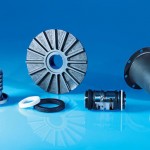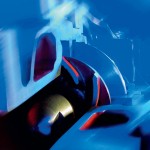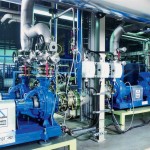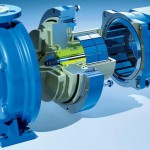Centrifugal pumps are utilised to pump a vast range of media, including acids, lye and solvents. However, this also means that they harbour the risks associated with these aggressive liquids. The following article illustrates the aspects that play a significant role in the design of centrifugal pumps and the differing safety requirements which pumps have to meet in modern production plants.
The author: Frank Pauly Sales Manager D A CH, Friatec – Rheinhütte Pumps Division
In terms of production engineering plants, centrifugal pumps represent the largest machinery group. They are subjected to particularly severe stress which is not limited solely to thermal, corrosive and abrasive influences. In addition to these, they are also exposed to especially severe loading caused by high flow rates and mechanical forces. This applies to the pumping of comparatively harmless media, such as service and waste water, but is primarily experienced in the case of chemical pumps which convey difficult liquids such as hydrogen sulphide, acids, bases and solvents.
The global increase in occupational and environmental safety requirements has influenced the available range of technologically mature safety solutions enormously in recent decades. Legislators in many places have created framework conditions that induce operators and manufacturers of plant and components to act with a maximum of care.
Does the optimum solution really exist? Is the subject of sealing the sole determining factor when it comes to safety? These are questions which can be justifiably posed. Economic principles, ultimately speaking, also apply to all production plants around the world, so another obvious question needs to be posed: are safe centrifugal pumps at all affordable?
One thing at least is certain, namely that, in the complex world of chemical process engineering, there is no universal solution which meets all the requirements of industrial applications to a uniform degree. The topics and views discussed here should, however, serve as an approach to a systematic analysis of the subject of safety.
In practice, a whole series of aspects plays a significant role at the Wiesbaden pump manufacturer Friatec – Rheinhütte Pumps Division. A risk analysis and, consequently, the design process can only begin when all operating characteristics and parameters are known. In order to operate centrifugal pumps in the long term, economically and – most importantly – safely, the selection of the most suitable materials, models, sealing concepts and monitoring equipment is of paramount importance for the company. This list may appear trivial, but daily practical experience indicates the speed at which faults can worm their way into the plant concepts of planners and operators and influence every single one of these factors. In addition to being an expensive nuisance, these faults can also ultimately develop into a safety risk which must be taken seriously.
The selection of material and design is among the most difficult tasks. Physical and chemical properties of the media to be pumped, operating parameters and ambient conditions not infrequently limit the selection of products in sophisticated world-scale plants and tax the creativity of plant designers.
While basic parameters such as flow (Q), discharge head (H), density (r), viscosity (h) and solid material content naturally determine the shape of the impeller of a centrifugal pump to a substantial degree, the installation situation of the pumps is left up to the plant concept when it comes to their later operating safety and reliability. For example, it makes a significant difference during risk assessment of the shaft sealing system whether the centrifugal pump is located beneath a tank or, as a vertical pump, is regarded as an integral part of the tank.
Pump material selection
A multitude of materials, including plastics, metals, ceramics or plastic linings, is available when selecting pump materials. Relevant selection criteria are not confined solely to corrosion behaviour and temperature limits, but also include hardness and resistance to wear. Thermal conductivity and electrical resistance are also extremely important when it comes to plant safety. This means that special conductive plastics can be used in potentially explosive atmospheres which ensure that no static charging leads to the formation of sparks (provided the pump is earthed).
In case of individual materials, properties which differ extremely mean that their selection should be governed by the material stress generated in the specific application case. The focus here is on the resistance to the pumped medium and the influence of plant and pump parameters.
With regard to the material involved, the Wiesbaden pump manufacturer enhances safety through the use of a complete casing. This means that plastics, for example, which are rendered brittle by UV rays are effectively protected by this measure. On the other hand, the pressure surge resistance of the centrifugal pump is improved by a complete casing in the case of brittle or soft materials such as ceramics and a few metallic materials.
Different sealing concepts
In addition to the significance of the pump material, the importance of selecting a suitable and reliable shaft sealing system is also indisputable when it comes to ensuring a long and efficient life cycle. There is no universal so- lution here: whether a hydrodynamic seal, mechanical seal or even magnetic actuation is involved – each of these shaft sealing concepts has its own special characteristics which individually influences plant safety. It is necessary to look at the whole picture here if a reliable solution is to be found.
Important selection criteria are the leakage rate, maintenance friendliness, failure probability, material resistance of the seal and monitoring options. Other advantages and disadvantages should be weighed up. Gland packing and mechanical seals are just some of the wear parts contained in centrifugal pumps, and these require maintenance and replacement from time to time. However, the hydrodynamic shaft seal functions without contact and without wear parts. A liquid ring seal configures itself in the vicinity of the auxiliary impeller and separates the interior of the pump from the atmosphere. The centrifugal pump does not require any maintenance if it is operated consistently and in accordance with regulations, and the failure probability is also extremely low. Solids in the pumped medium are thus kept out of the shaft passage through this relief effect.
A focus on special seals
If, for example, a mechanical seal is designated for use in certain applications, the correct seal design is decisive when it comes to plant safety and availability and ensuring environmental protection. The enormous choice involved can be categorised as follows:
- Single or double acting mechanical seals
- Standard seals or cartridge units
- Mechanical seals with or without sealing liquid
- Pressurised or non-pressurised mechanical seals
The mechanical seal which should ultimately be used depends on the overall plant and process characteristics involved. It can, fundamentally, be said that the more complex a mechanical seal is, the higher its installation and maintenance outlay. A trouble-free supply of sealing liquid should be ensured when using double acting mechanical seals. The sealing liquid acts as a lubricant for the sealing surfaces and as a barrier between the medium and the environment.
Magnetic drive pumps are distinguished by the fact that the drive and impeller are hermetically separated from each other. The drive output is transmitted contact-free through magnets. When handling highly aggressive and hazardous substances in particular, specialists enjoy enormous advantages where a hermetically sealed magnetic drive pump is used.
On the one hand, it reliably separates the prod-uct chamber from the environment, thus excluding the risk of pumped medium emerging and preventing pollution of the environment with ecologically harmful media. On the other hand, this pump is extremely efficient, as maintenance costs are kept to a minimum through the wear-free operation of the magnetic drive unit.
Monitoring equipment
Few topics relating to pumps are discussed as frequently or cause as much controversy as pump monitoring. The background situation and motivation behind monitoring differ greatly in this respect. A significant reason for monitoring arises from explosion protection requirements which are governed by specific national standards in different countries. Typical monitoring equipment includes filling level limit switches, load monitors, temperature monitoring devices, pressure gauges, flow meters, vibration meters and complex monitoring systems.
Despite all the technical devices which support operating safety, the human factor should never be forgotten. Only regular inspections and servicing can ensure that pump systems are safe. Maintenance friendliness and modern pump designs also ensure that damage to a pump is minimised and, consequently, enhance operating safety.
However, should damage still occur, the remedial action taken should be as uncomplicated and speedy as possible. Many symmetrical components which prevent confusion can be found in modern pump designs to avoid errors in this respect.
Investment in the future
Safety appears to be expensive in advance, as complex technologies frequently need to be employed. However, experience indicates that the initial capital investment pays off when the life cycle costs are considered. The reason for this is that an expensive pump amortises if no damage occurs, and it also requires less maintenance than a less expensive pump. Consequently, greater safety need not inevitably lead to higher costs.
Cost reduction measures primarily affect standardisation issues: the same pump types and sizes, the same sealing concepts, central monitoring systems, efficient stock maintenance and employee training.
Experienced centrifugal pump specialists examine and take all plant and process aspects into consideration during product design. This is the only way to pinpoint an optimum so- lution that ensures plant safety from the outset and minimises the risk of failure and, consequently, overall costs.
Online-Info: www.cpp-net.com/2211435
Share:










